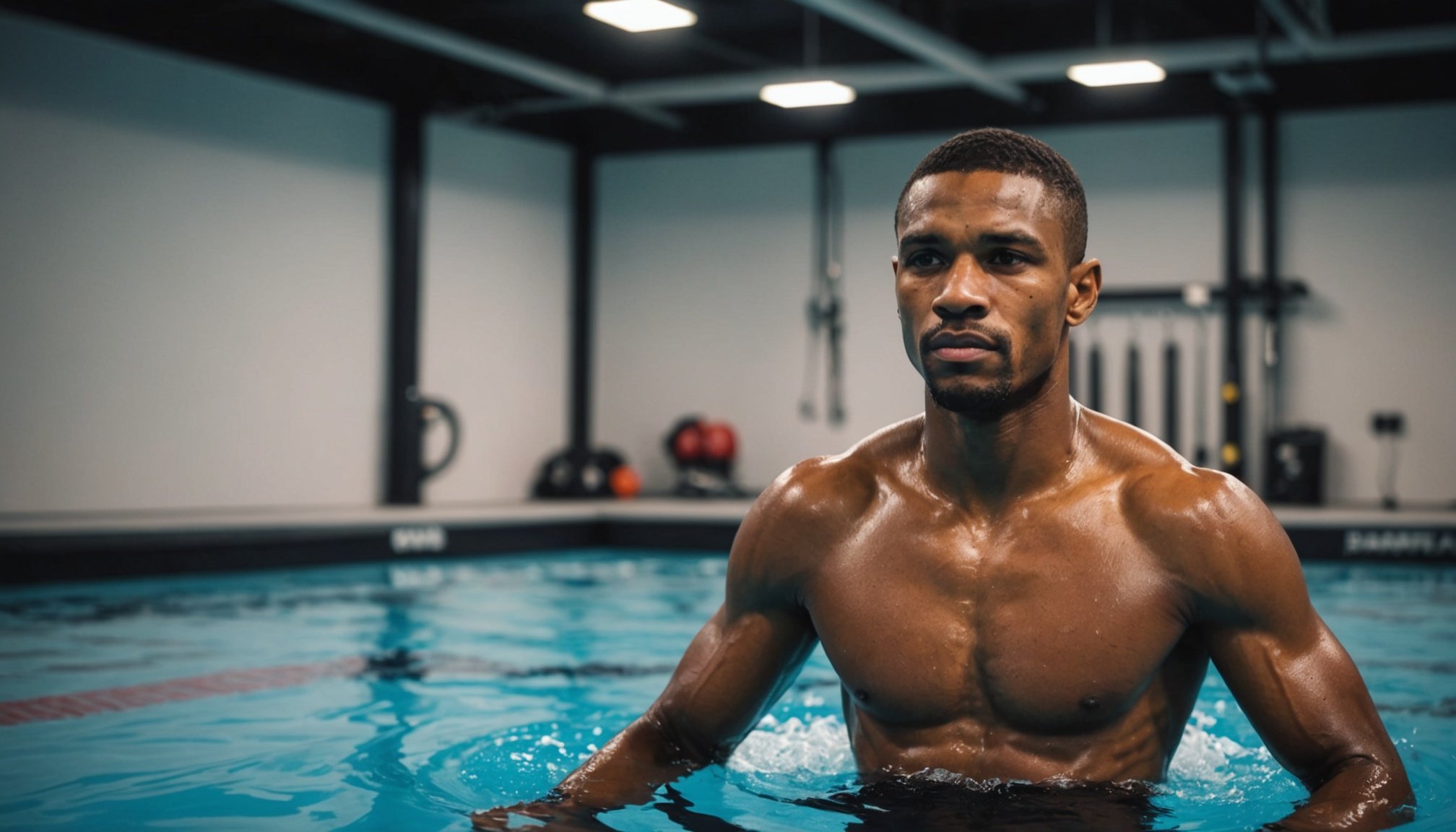Understanding Hydrotherapy for Athletic Recovery
Hydrotherapy, an innovative recovery method, is becoming increasingly popular among athletes for its comprehensive benefits to athletic recovery. It encompasses various techniques that utilise water to rehabilitate the body and alleviate discomfort. The principles of hydrotherapy lie in its ability to exploit water’s thermal and mechanical effects, aiding in the hastening of recovery post-exertion.
There are numerous types of hydrotherapy techniques utilised by athletes to optimise their performance and recovery. Popular methods include contrast baths, where athletes alternate between hot and cold water immersion to stimulate blood flow and reduce muscle fatigue. Other techniques like underwater massage and hydrostatic pressure application enhance circulation and lymphatic drainage.
Also to see : Unlocking speed: the game-changing role of 3d printed custom footwear in enhancing sprint performance
Physiologically, hydrotherapy impacts the body by improving blood circulation and facilitating a quicker clearance of metabolic waste. When used as part of an athletic recovery regimen, it effectively reduces inflammation and muscle soreness, allowing athletes to maintain peak performance levels. The relaxing nature of hydrotherapy also contributes to psychological welfare, reducing stress and promoting relaxation.
Overall, incorporating hydrotherapy into athletic routines can substantially benefit not only physical recovery but also enhance an athlete’s mental well-being, encouraging a holistic approach to sports recovery.
Also read : What Innovations Are Revolutionizing UK Sports?
Benefits of Hydrotherapy for Elite Boxers
Understanding the benefits of hydrotherapy is crucial for elite boxers aiming to enhance their performance. This method is highly effective in facilitating muscle recovery and minimizing soreness. Engagement in hydrotherapy aids in accelerated healing by reducing lactic acid buildup, thereby significantly decreasing muscle fatigue post-training.
Moreover, hydrotherapy also plays a pivotal role in improving blood circulation. The varying temperatures employed in techniques like contrast baths promote vasodilation and vasoconstriction, which optimize blood flow. Enhanced circulation ensures better delivery of nutrients and oxygen to the muscles, while simultaneously aiding in inflammation reduction.
The mental benefits should not be underestimated either, as hydrotherapy contributes significantly to relaxation. This technique lowers cortisol levels, reducing stress and anxiety, which is crucial for maintaining focus and mental stability in demanding training regimes. The calming influence of hydrotherapy promotes a sense of well-being, ensuring boxers remain mentally and physically prepared for challenges.
Thus, incorporating this recovery method can bolster an athlete’s performance, whether they’re recovering from intense workouts or managing stress levels. By understanding and utilizing hydrotherapy, elite boxers can achieve optimal physical and psychological states.
Scientific Evidence Supporting Hydrotherapy
Scientific research strongly supports the benefits of hydrotherapy for performance improvement in athletes, particularly boxers. Various hydrotherapy studies have analysed its effectiveness in enhancing athletic performance and promoting recovery. One pivotal study revealed significant muscle recovery improvements in athletes who incorporated hydrotherapy into their routines.
The analysis of research findings shows a notable impact on boxing performance. This includes hastened muscle recuperation and reduced soreness leading to improved training outputs. Enhanced circulation attributed to hydrotherapy aids efficient delivery of nutrients to muscles, a factor critical in competitive sports.
Experts further underscore the relevance of hydrotherapy in athletic training, citing reduced inflammation and quicker recovery times as substantial benefits for elite athletes. By integrating scientifically-backed hydrotherapy techniques, athletes like boxers can substantially improve recovery processes, optimising both physical and mental readiness.
Overall, the cumulative insights from key studies affirm hydrotherapy’s role in not just easing soreness but also in boosting performance. Utilising this method, boxers can fortify their athletic abilities, ensuring resilience against both physical exertion and competitive stresses. These findings reflect hydrotherapy’s potential in achieving a sustained competitive edge.
Practical Hydrotherapy Techniques for Boxers
Exploring hydrotherapy techniques can significantly enhance a boxer’s recovery routine. Popular methods such as contrast baths and underwater massage are prominently utilized to aid in swift recovery post-training. Contrast baths involve alternating between hot and cold water immersions, which stimulate blood flow and help alleviate muscle soreness. Engaging in underwater massage, on the other hand, utilizes water jets to provide a deep tissue massage that enhances lymphatic drainage and muscle relaxation.
To effectively implement these techniques, athletes should integrate them into a structured boxing recovery routine. This involves selecting the appropriate duration and sequence for each technique based on training intensity and muscle fatigue levels. For instance, a session might start with a 3-minute hot immersion, followed by a 1-minute cold immersion, repeating the cycle several times.
Boxers must also consider safety and best practices for hydrotherapy use. It’s essential to monitor body temperature to avoid overheating or hypothermia during sessions. Furthermore, consulting with a sports therapist or coach can provide valuable guidance tailored to individual recovery needs. Emphasising safety ensures athletes maximise the benefits of hydrotherapy while minimising risks.
Case Studies: Hydrotherapy in Action
Exploring hydrotherapy success stories provides valuable insights into its practical benefits. Several elite boxers have successfully integrated hydrotherapy into their routines, reporting significant performance gains.
One notable example involves a top-ranked boxer who incorporated underwater massage and contrast baths into their recovery regimen. This athlete noted drastic improvements in muscle recovery, allowing them to maintain higher training intensities with reduced fatigue. Few testimonials are as compelling as firsthand experiences; athletes consistently express how hydrotherapy facilitates quicker recoveries and boosts readiness for subsequent sessions.
In interviews, numerous trainers echo these sentiments, highlighting how hydrotherapy assists athletes in reaching peak performance by managing muscle stress levels. Through comparative analysis, it’s clear that athletes embracing hydrotherapy experience enhanced recovery times, overall better stamina, and sustained performance in the ring.
Such narratives not only posit hydrotherapy as a formidable tool in sports recovery, they also showcase the method’s varied applications and adaptability, systematised to meet professional athletes’ rigorous demands. These case studies underline the transformative impact hydrotherapy can have, further solidifying its position as a cornerstone of modern athletic recovery practices.
Comparing Hydrotherapy with Other Recovery Methods
When assessing recovery methods, a comprehensive understanding of various options reveals unique benefits for athletic recovery. Hydrotherapy stands out due to its multifaceted approach, utilising water’s properties to optimise recovery. In contrast, cryotherapy involves exposing the body to extremely cold temperatures, which can rapidly reduce inflammation and muscle pain. While effective, cryotherapy doesn’t offer the same relaxation benefits.
Massage therapy targets muscle knots and tension, improving flexibility and reducing pain. However, unlike hydrotherapy, it may not enhance circulation as dynamically through temperature variation.
In a direct comparison, hydrotherapy boasts several advantages:
- Flexibility: Can feature hot and cold treatments.
- Multi-purpose: Simultaneously supports physical and mental recovery.
- Accessibility: Can be practiced with simple setups like home baths.
Yet, considerations about facility requirements and session planning can be downsides for hydrotherapy.
To choose the right method, athletes must evaluate individual needs, balancing physical demands with personal preferences. For some, integrating a mix of these methods ensures holistic recovery, maximizing both physiological and psychological benefits. The key is to ensure each athlete’s plan aligns with their specific recovery and performance goals.
Integrating Hydrotherapy into a Boxer’s Training Program
Incorporating hydrotherapy into a boxer’s training regime can be a game-changer. Creating a personalized recovery schedule is key, tailoring the use of hydrotherapy to fit individual training demands. A well-thought-out schedule enhances performance and prolongs an athlete’s career by ensuring optimal recovery. It involves balancing hydrotherapy sessions with other recovery methods, allowing rest and physical rejuvenation while maintaining the rigour of their training.
A practical approach might include scheduling contrast baths post-intensive workouts, using underwater massage on days of high muscle exertion, and assigning passive rest days to maximise overall recovery. Knowing when and how to integrate these sessions into training cycles can provide athletes with comprehensive benefits in physical and mental wellness.
A boxer should consider including weekly cycles of varied hydrotherapy techniques to not only reduce muscle tension but also manage stress levels efficiently. It’s of paramount importance to align these practices with sport-specific recovery goals to avert overtraining.
In the long-term, athletes can expect sustained performance gains, better injury prevention, and enhanced psychological resilience by structuring these recovery methods into their rigorous routines. Embracing such a holistic recovery approach ensures resilience amidst the demands of competitive boxing.

